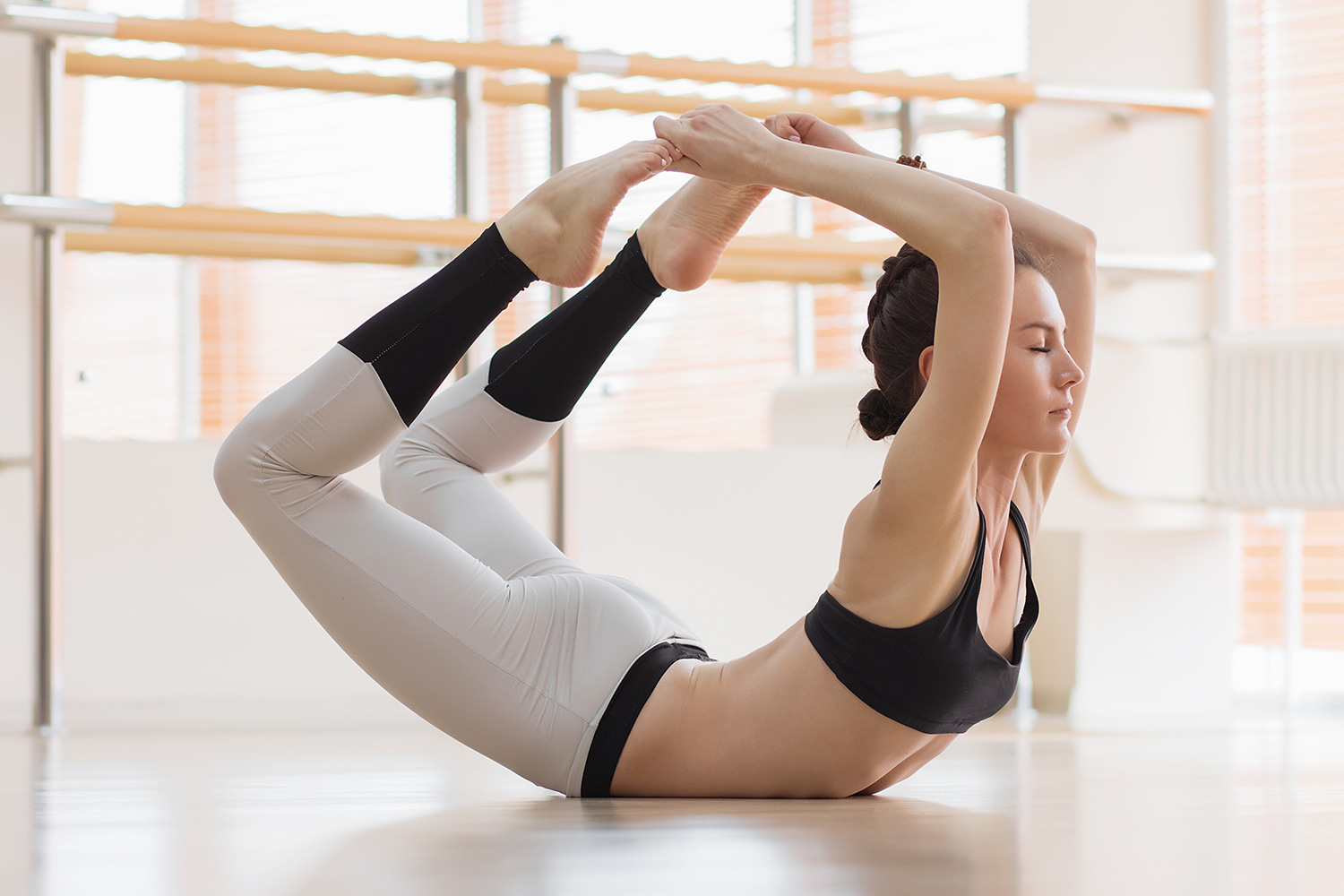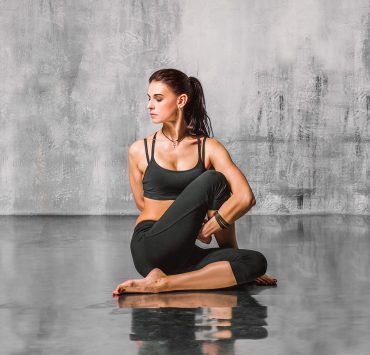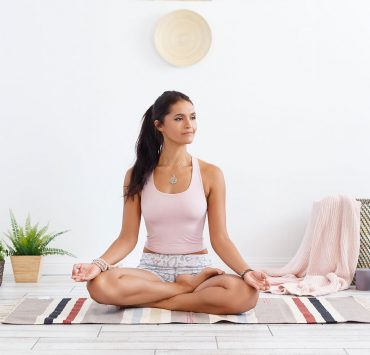
After spending nearly two decades as a relationship therapist, Patricia…
If you’re brand-spanking’ new to the world of yoga, there are a few things you should know to start you off on the right foot (and sometimes the left, but we’ll get to that later). As humans, we crave routine and ritual, but we tend to create excuses and obstacles for ourselves as to why we can’t start a yoga practice today. Well, the time is now – And you’re well on your way to building the strength and confidence it takes to live a fulfilled life using yoga as a vehicle for change. Here’s everything you need to know to start your yoga journey from the numerous benefits to the basic poses you’ll grow to know and love. Namaste.
Origins Of Yoga

Yoga originated as an ancient technique for achieving harmony between the mind and body on the journey to enlightenment. It originated in India around 3000 BC where, in the Indus Valley, figures carved in stone depict yoga postures. Sanskrit, the Indo-European language of ancient Indian religion, constitutes the foundation for yogic theory and technique. The Sanskrit word ‘yoga’ has several translations, but the most common understanding describes a union or a sacred system of discipline. The Indian sage Patanjali is recognized as the creator of an oral tradition in which yogic philosophy is conveyed directly from teacher to student. His classical work, the Yoga Sutras, continue to be referenced in teacher trainings around the world and provide the structure upon which all yoga is based. The physical component of yoga, or Hatha yoga, was initially used as a vehicle for meditation. The postures prepare the body and mind for the necessary stillness meditation demands. Today, the physical practice of yoga has become a path for radical self-transformation and the most commonly exercised limb of yoga.
Benefits Of Yoga

Improved Flexibility. Consistent practice of yoga asanas can make your body more flexible and give your muscles and joints a vaster range of motion. Flexibility leads to fewer injuries, improved quality of life, and an easier time adapting to the aging process.
Stronger & More Toned Body. Strong, toned muscles not only improve our self-confidence, but they also protect us from injuries and chronic pain. Most people don’t immediately turn to yoga when they’re looking to trim up or gain muscle, but don’t be fooled – Many postures are quite physically demanding and require an immense amount of core stability to maintain.
Reduced Stress. If everyday stress is negatively impacting your life, you might want to consider hitting the mat and giving yoga a whirl. Yoga combines physical postures, controlled breathwork, and meditation to bring a sense of calm to both body and mind. By lowering your blood pressure and heart rate, yoga is a highly effective tool for managing stress.
Increased Happiness. Aside from the usual pick-me-up we experience from all physical exercise, yoga is proven to enhance mental and physical health in the long-term. The combination of postures, meditation, and breathwork improve psychological well-being by boosting self-esteem, reducing stress, and eliminating anxiety.
Enhanced Mindfulness. Yoga teaches us to embrace every breath and move with clear intention. This sort of ‘moving meditation’ promotes an awareness that greatly improves our quality of life. Practicing yoga has been proven to improve mindfulness not just in class, but in daily life as well.
Heightened Energy & Metabolism. The metabolic processes responsible for giving the body energy are regulated by the endocrine system, particularly the thyroid. Yogas stimulating and strengthening effect on the endocrine system make it extremely useful for boosting metabolism and bringing a boost of energy.
Better Focus & Clarity. Those who regularly practice yoga will notice a sincere reduction in their stress levels as yoga calms the nervous system. Breathwork, postures, and meditation all work together to our lower blood pressure, heart rate, and cortisol levels – Resulting in a calmer, clearer, and more balanced state of mind.
Styles Of Yoga

Vinyasa Flow. Movement and breath come together in this dynamic, fluid style. Vinyasa classes move through postures in a quicker, dance-like way that raises heart rates and moods. Teachers will often use music to match the sequence of postures and motivate students to keep moving.
Yin / Restorative. Yin and Restorative, though different styles, have several similarities. They both employ the use of props and long holds to evoke deep, calming relaxation. These meditative practices are designed to restore length and elasticity to deep connective tissues while tapping into the parasympathetic nervous system.
Hatha. It’s all about the basics in these slower-paced classes that ask you to stay in each pose for several breaths. Many studios consider Hatha classes to be a gentler form of yoga. However, the Sanskrit term “Hatha” actually applies to any style of yoga that teaches physical poses.
Ashtanga. If you’re keen on challenging postures in an orderly fashion, Ashtanga is the style for you! This ancient practice consists of six series of sequenced postures that aim to build heat. The poses are always performed in the exact same order, and the series gradually become more advanced.
Bikram. If you enroll in a Bikram class, you best get ready to sweat! These classes consist of twenty-six specifically sequenced postures and two breathing exercises in a heated room. The ninety-minute sequence is the same wherever you go, so you always know what’s in store when you roll out your mat.
Iyengar. Iyengar yoga leaves no prop untouched in the pursuit of proper alignment and keen attention to detail. From yoga blocks and blankets to straps and bolsters – Each prop serves to help you find a safe and effective range of motion in all postures.
Poses You Should Know
Adho Mukha Svanasana — Downward Facing Dog Pose

Arguably the most popular yoga pose of them all – Downward Facing Dog offers practitioners a healthy balance of strength and flexibility. Most yoga classes highlight this classic asana at least a few times, so it’s smart to get to know the proper alignment beforehand. Begin in a tabletop position with wrists slightly ahead of the shoulders and palms planted at shoulder-width. Tuck the toes and lift the hips skyward while extending the legs as straight as possible.
Virabhadrasana I — Warrior I Pose

Warrior I is a great pose for anyone who spends a decent amount of their day seated and a popular posture in Vinyasa Flow classes. It relieves tension in the hips and lower back while stretching the hamstrings and glutes. Start standing and take a wide step out, turning the back foot out at a 45-degree angle. Direct the toes of your front foot straight ahead, and on an exhale, bend the front knee over the ankle. Squeeze the thighs as you raise both arms overhead. Move hip of your bent leg back as you sink the pelvis down and forward.
Trikonasana — Triangle Pose

Triangle Pose actually has less to do with geometry and more to do with the creation of space in the spine and legs. Begin standing tall at the head of your mat and take a wide step back. Turn your back foot out slightly and direct the toes of your front foot straight ahead. Inhale your arms out in a T-shape, and as you exhale, reach forward over the front leg. Bring your front hand down to rest on either the shin or a block as you reach the back hand straight up. Engage through the core and broaden across the chest as you breathe here.
Uttanasana — Standing Forward Fold Pose

Standing Forward Folds are more than just a method for alleviating back pain – They empower us to witness a change in the body as our flexibility gradually increases. With the feet at hip-distance, exhale to let the upper body drape freely over the legs, keeping them as bent as needed. Let the arms go heavy to the floor, or grab opposite elbows and allow yourself to surrender to gravity.
Urdhva Mukha Svanasana — Upward Facing Dog Pose

If you find yourself in a Vinyasa flow class, then it’s likely you’ll meet Upward Facing Dog at least a couple times. It’s an excellent back bend that opens the entire front line of the body. Start by lying on your belly with tops of the feet planted and palms under the shoulders. On an inhale press the arms to straight and keep your gaze forward. Roll the shoulders back away from the ears as you elevate your crown towards the ceiling and engage the lower body.
Vrksasana — Tree Pose

Balancing asanas, such as Tree Pose, stimulate and focus our mind while toning the muscles of the core and lower body. From a standing position, begin to root down through one foot and slowly bring your opposite foot up to either the inner thigh, mid-calf, or kickstand it on the ankle of the standing leg. Open the bent knee back as the hands come to rest at hearts center.
Eka Pada Rajakapotasana — Pigeon Pose

Quite possibly the greatest hip-opening posture of all time – Pigeon Pose. The most common method for entering this pose is starting in Downward Facing Dog and carefully bringing one shin forward with the knee behind the wrist of the same side. Lengthen the opposite leg straight back, ensuring that it stays in line with the hip point. It can be highly beneficial to bring a block, blanket, or bolster under the hip of the bent leg as you start to ease into this deep stretch.
What's Your Reaction?
After spending nearly two decades as a relationship therapist, Patricia journeyed down the path of writing as a vehicle for sharing her wisdom. Her work reflects a sincere interest in readers’ wellbeing and is abundant with helpful advice and fascinating insight.














